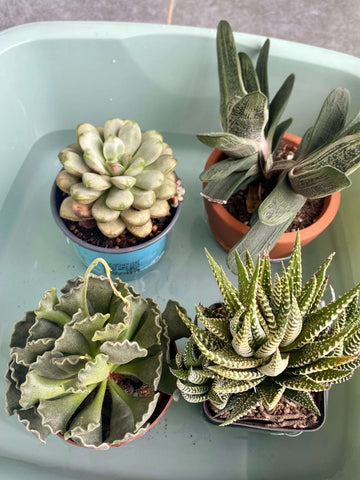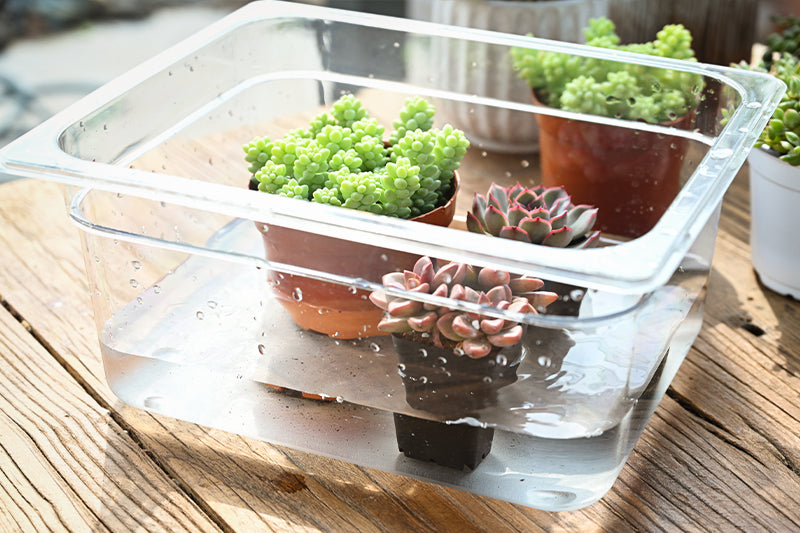
Succulents do require constant watering during their growing seasons. But after they enter a latent phase, they hardly ever need water to survive.
Succulents should be bottom watered to prevent overwatering by giving the soil the right quantity of moisture. The soil only absorbs as much water as it can hold before draining freely and being sufficiently moist. Succulents’ soft and mushy leaves caused by overwatering are avoided by bottom watering.
This article outlines the advantages of bottom watering succulents over top watering or misting as well as the reasons why it is preferable.
Table of Contents
Why Do Succulents Love Bottom Watering?
Bottom watering is a strategy that ensures people provide their succulents with the ideal amount of water to keep them healthy and everlasting.
What is Bottom Watering?
By setting the plant in a tray of water that is 1 to 2 inches high, bottom watering is accomplished. Following this, the water is allowed to drain freely, leaving the soil moist and aerated. The water is subsequently absorbed into the soil from the bottom up.
Watering the bottom:
- encourages the formation of strong roots
- prevents gnats and other pests
- minimizes overwatering
- enables the soil to breathe fresh air
With this technique, you submerge your succulent pot in a water-filled container so that it can absorb enough water for its roots to operate normally.
See our comprehensive guide for bottom-watering plants, which provides clear explanations and step-by-step directions.
Small and medium-sized succulent plants prefer bottom watering since it protects them from overwatering, which is one of the main reasons why they appreciate it so much.
The following reasons are listed below as to why succulents enjoy bottom watering:
Efficiency
Succulents can be effectively hydrated without being overwatered or underwatered by using bottom watering.
It is the finest method for replenishing moisture in plant soil without overwatering.
Keep The Soil Uniform
The soil is kept consistent by bottom watering as well. Cactus soil, loamy soil, gravel, volcanic rock, and other such surfaces are good for growing succulents.
Unexpectedly, Bottom watering is effective with each of these soil types.
The growth of plants is significantly influenced by the various types of soil. In well-drained soil, bottom watering aids in the plant’s health.
The crucial component of plant growth and an essential component of well-drained soil is o.
When soil is properly drained, plants receive adequate water in accordance with their requirements and maintain health.
Supply of Enough Moisture
The greatest source to give the plant enough moisture is a water succulent. Top watering makes this impossible.
Because watering a plant from the top often only moistens the upper surface and does not supply the roots with the necessary moisture.
When you water a plant from the bottom, the roots uniformly take the water and nutrients.
Get Rid of Pests
By reducing the circumstances that indoor pests adore, bottom watering maintains the surface moist for a brief period of time, allowing your succulents’ leaves to flourish.
Moist soil attracts pests like gnats. Therefore, if you can avoid keeping your potting soil or growing medium wet for extended periods of time, it will slow the development of gnats around your succulents.
The topsoil typically remains dry while bottom watering, especially the 1 to 2 inches of growth medium surface where fungus gnat larvae thrive.
Encourage Root Development
The roots of a plant receive enough water when watered from the bottom, along with nutrients and minerals including sodium, potassium, sulfur, and phosphorus.
Roots typically grow more healthily as they receive only the necessary amount of water when the entire soil mass is exposed to water through the wicking action of the water from the bottom to the top.
Water cannot saturate the air voids and deprive the roots of oxygen, which can cause root rot and other fungi-related problems.
How Can You Make Well-Drained Soil For Bottom Watering?
Bottom watering works best in soil that drains well. Sand’s little coarser texture aids in the uniform distribution of water throughout the area, which causes plants to absorb water more regularly.
Well, it’s not very difficult to prepare well-drained soil for bottom watering. Sandal soil and loam (clay 20% and silt 40%) are examples of well-drained soil.
By simply adhering to the advice provided below, you may create well-drained soil at home.
- Use a shovel to dig the soil, trying to lose as much of it as you can.
- Compostable materials like clay and sand should be added.
- You will get better-drained soil if you plough it deeper.
The infiltration (transfer of water into the soil) and percolation processes are both aided by well-drained soil (downward movement of water within the soil).
Succulent Plants That Like Bottom Watering?
If we water succulent plants from the bottom as opposed to the top, they remain healthy and green.
We’ve prepared a list of succulent plants that do best with bottom water down below:
- Cissus
- Jade tree
- Viper plant
- Pothos
- Ponytail
- tadpole plant
- black violets
- tagging-on plants
Additionally, watermelon pepperoni enjoys bottom watering.
Piggyback Plants
With bottom watering, succulents like Piggyback plants grow the best. That is primarily due to the fact that they dislike damp leaves like watermelon pepperoni.
They must be watered from the bottom to prevent moist leaves.
African violet
Bottom watering is preferred for this lovely pulpy plant in order to prevent discolored leaves.
Snake plant
This plant thrives in sandy, loamy soil and prefers a pH of neutral. Because water is evenly delivered throughout their entire root system through this soil, they prefer bottom watering.
Cissus
in soil that is consistently damp. It is assisted in obtaining the vital moisture required for its healthy growth and operation by bottom watering.
How To Bottom Water Succulent?
Bottom watering a succulent is a simple procedure that can be completed at home with minimal effort. You should simply take the following simple actions:
Step 1:
Get a tray or a water bowl ready. Add nearly 1 inch of water to it. Make sure there are no rocks inside the container as they may stop the bottom from watering.
But if any are present, then balance the soil and water levels. to make it simple for the roots to get into contact with water.
Step 2:
Put your succulent planter directly into the water. Also keep in mind that the pot needs to have one or two drainage holes so that it can get adequate water to absorb via them.
For 15 to 20 minutes, keep the plant. until the top inch of the soil is damp.
Step 3:
Take the plant out of the water and place it in an empty container after checking the soil’s moisture content. This will allow the surplus water to drain out and prevent root rot.
Step 4:
Ensure it is clean and dry before putting it back where it belongs. You’ve successfully watered the plant from the bottom. You can now return the plant to its original location.
How Long To Bottom Water Succulent
A plant has to be bottom watered for about 15 to 20 minutes on average.
Depending on the soil drainage quality and whether there is rock at the bottom, a plant may require extra time to grow in really harsh conditions. It can take a little while longer.
If you want to be extra certain, check the topsoil of your succulents. When the top of the soil feels moist to the touch, it’s time to take the succulent out of the watering tray.
How Often is The Bottom Water Succulent?
How frequently and for how long it should be bottom watered completely depends on the succulent circumstances you have.
Once every two weeks, the bottom of a succulent needs to be watered. Underwatering a plant is not as terrible as overwatering it.
Keep an eye on it, and when you notice that your succulent’s leaves are wrinkled or shriveled, place it in a water container right away to give it a bottom watering.
The most typical signs of plant dryness or underwatering are wrinkled or withered leaves.
If the leaves appear healthy and full, your succulent has enough water and doesn’t need to be overwatered.
See our in-depth post for information on how frequently to bottom water plants.
The Takeaway:
However, caring for succulents is simple, and they only require a little maintenance to flourish.
The most frequent issues succulents face, though, are underwatering and overwatering. Fortunately, bottom watering can prevent both of these issues.
Bottom watering is an excellent way to prevent overwatering because it lets the water to disperse evenly throughout your succulents.
FAQ
How long should I let my succulents bottom water?
If you want to bottom water several plants, you can put the pots into a dish or tub of water and let them soak there for 20 to 30 minutes before removing them and re-potting them.
Can you overwater succulents by bottom watering?
Succulents actually require watering just like every other plant you care for. But a succulent plant can be overwatered. Cacti, variants of Aloe, Echeveria, and other succulents store water in their thick leaves and stems since they often grow in desert regions.
Is bottom watering better for succulents?
Repairing hydrophobic soil that is hard, dry, compact, and water-repellent can be done extremely well by bottom-watering. Going future, routine bottom-watering will stop the issue from recurring. There isn’t enough soil when the roots of your succulent plant are too overgrown to prevent top-watering.
Should succulents be watered bottom up?
Repairing hydrophobic soil that is hard, dry, compact, and water-repellent can be done extremely well by bottom-watering. Going future, routine bottom-watering will stop the issue from recurring. There isn’t enough soil when the roots of your succulent plant are too overgrown to prevent top-watering.
Should I water succulents from the bottom?
When you water from the bottom of the pot rather than the top, the roots are forced to reach for the water because they can feel it there. They gain strength and size as a result.

